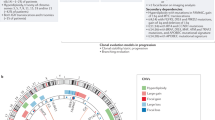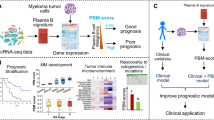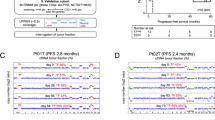Abstract
Multiple myeloma (MM) patients undergo repetitive bone marrow (BM) aspirates for genetic characterization. Circulating tumor cells (CTCs) are detectable in peripheral blood (PB) of virtually all MM cases and are prognostic, but their applicability for noninvasive screening has been poorly investigated. Here, we used next-generation flow (NGF) cytometry to isolate matched CTCs and BM tumor cells from 53 patients and compared their genetic profile. In eight cases, tumor cells from extramedullary (EM) plasmacytomas were also sorted and whole-exome sequencing was performed in the three spatially distributed tumor samples. CTCs were detectable by NGF in the PB of all patients with MM. Based on the cancer cell fraction of clonal and subclonal mutations, we found that ~22% of CTCs egressed from a BM (or EM) site distant from the matched BM aspirate. Concordance between BM tumor cells and CTCs was high for chromosome arm-level copy number alterations (≥95%) though not for translocations (39%). All high-risk genetic abnormalities except one t(4;14) were detected in CTCs whenever present in BM tumor cells. Noteworthy, ≥82% mutations present in BM and EM clones were detectable in CTCs. Altogether, these results support CTCs for noninvasive risk-stratification of MM patients based on their numbers and genetic profile.
This is a preview of subscription content, access via your institution
Access options
Subscribe to this journal
Receive 12 print issues and online access
$259.00 per year
only $21.58 per issue
Buy this article
- Purchase on Springer Link
- Instant access to full article PDF
Prices may be subject to local taxes which are calculated during checkout





Similar content being viewed by others

Data availability
WES and arrays data that support the findings of this study have been deposited in the European Genome-phenome Archive (ENA) with the following accession codes: EGAS00001004288 and EGAS00001004314. Data will be available immediately following publication, no end date. All other data and processing code are available from the corresponding author upon reasonable request.
References
Rajkumar SV, Gupta V, Fonseca R, Dispenzieri A, Gonsalves WI, Larson D, et al. Impact of primary molecular cytogenetic abnormalities and risk of progression in smoldering multiple myeloma. Leukemia. 2013;27:1738–44.
Palumbo A, Avet-Loiseau H, Oliva S, Lokhorst HM, Goldschmidt H, Rosinol L, et al. Revised international staging system for multiple myeloma: a report from international myeloma working group. J Clin Oncol. 2015;33:2863–9.
Rasche L, Chavan SS, Stephens OW, Patel PH, Tytarenko R, Ashby C, et al. Spatial genomic heterogeneity in multiple myeloma revealed by multi-region sequencing. Nat Commun. 2017;8:268.
Snyder MW, Kircher M, Hill AJ, Daza RM, Shendure J. Cell-free DNA comprises an in vivo nucleosome footprint that informs its tissues-of-origin. Cell. 2016;164:57–68.
Wan JCM, Massie C, Garcia-Corbacho J, Mouliere F, Brenton JD, Caldas C, et al. Liquid biopsies come of age: towards implementation of circulating tumour DNA. Nat Rev Cancer. 2017;17:223–38.
Lohr JG, Kim S, Gould J, Knoechel B, Drier Y, Cotton MJ, et al. Genetic interrogation of circulating multiple myeloma cells at single-cell resolution. Sci Transl Med. 2016;8:1–10.
Kis O, Kaedbey R, Chow S, Danesh A, Dowar M, Li T, et al. Circulating tumour DNA sequence analysis as an alternative to multiple myeloma bone marrow aspirates. Nat Commun. 2017;8:15086.
Mithraprabhu S, Khong T, Ramachandran M, Chow A, Klarica D, Mai L, et al. Circulating tumour DNA analysis demonstrates spatial mutational heterogeneity that coincides with disease relapse in myeloma. Leukemia. 2017;31:1695–705.
Bolli N, Avet-Loiseau H, Wedge DC, Van Loo P, Alexandrov LB, Martincorena I, et al. Heterogeneity of genomic evolution and mutational profiles in multiple myeloma. Nat Commun. 2014;5:2997.
Kumar SK, Rajkumar SV. The multiple myelomas—current concepts in cytogenetic classification and therapy. Nat Rev Clin Oncol. 2018;15:409–21.
Walker BA, Mavrommatis K, Wardell CP, Cody Ashby T, Bauer M, Davies FE, et al. Identification of novel mutational drivers reveals oncogene dependencies in multiple myeloma. Blood. 2018;132:587–97.
Manier S, Park J, Capelletti M, Bustoros M, Freeman SS, Ha G, et al. Whole-exome sequencing of cell-free DNA and circulating tumor cells in multiple myeloma. Nat Commun. 2018;9:1–11.
Guo G, Raje NS, Seifer C, Kloeber J, Isenhart R, Ha G, et al. Genomic discovery and clonal tracking in multiple myeloma by cell-free DNA sequencing. Leukemia. 2018;32:1838–41.
Bladé J, Fernández de Larrea C, Rosiñol L. Extramedullary disease in multiple myeloma in the era of novel agents. Br J Haematol. 2015;169:763–5.
Garcés JJ, Simicek M, Vicari M, Brozova L, Burgos L, Bezdekova R, et al. Transcriptional profiling of circulating tumor cells in multiple myeloma: a new model to understand disease dissemination. Leukemia. 2019. https://doi.org/10.1038/s41375-019-0588-4.
Bianchi G, Kyle RA, Larson DR, Witzig TE, Kumar S, Dispenzieri A, et al. High levels of peripheral blood circulating plasma cells as a specific risk factor for progression of smoldering multiple myeloma. Leukemia. 2013;27:680–5.
Gonsalves WI, Rajkumar SV, Gupta V, Morice WG, Timm MM, Singh PP, et al. Quantification of clonal circulating plasma cells in newly diagnosed multiple myeloma: implications for redefining high-risk myeloma. Leukemia. 2014;28:2060–5.
Sanoja-Flores L, Flores-Montero J, Garcés JJ, Paiva B, Puig N, García-Mateo A, et al. Next generation flow for minimally-invasive blood characterization of MGUS and multiple myeloma at diagnosis based on circulating tumor plasma cells (CTPC). Blood Cancer J. 2018;8:117.
Kumar S, Rajkumar SV, Kyle RA, Lacy MQ, Dispenzieri A, Fonseca R, et al. Prognostic value of circulating plasma cells in monoclonal gammopathy of undetermined significance. J Clin Oncol. 2005;23:5668–74.
Mishima Y, Paiva B, Shi J, Park J, Manier S, Takagi S, et al. The mutational landscape of circulating tumor cells in multiple myeloma. Cell Rep. 2017;19:218–24.
Paiva B, Puig N, Cedena M-T, Rosiñol L, Cordón L, Vidriales M-B, et al. Measurable residual disease by next-generation flow cytometry in multiple myeloma. J Clin Oncol. 2019. https://doi.org/10.1200/JCO.19.01231.
Misund K, Keane N, Stein CK, Asmann YW, Day G, Welsh S, et al. MYC dysregulation in the progression of multiple myeloma. Leukemia. 2020;34:322–6.
Cavo M, Terpos E, Nanni C, Moreau P, Lentzsch S, Zweegman S, et al. Role of 18F-FDG PET/CT in the diagnosis and management of multiple myeloma and other plasma cell disorders: a consensus statement by the International Myeloma Working Group. Lancet Oncol. 2017;18:e206–17.
López-Anglada L, Gutiérrez NC, García JL, Mateos MV, Flores T, San Miguel JF. P53 deletion may drive the clinical evolution and treatment response in multiple myeloma. Eur J Haematol. 2010;84:359–61.
Razavi P, Li BT, Brown DN, Jung B, Hubbell E, Shen R, et al. High-intensity sequencing reveals the sources of plasma circulating cell-free DNA variants. Nat Med. 2019;25:1928–37.
Chakraborty R, Muchtar E, Kumar SK, Jevremovic D, Buadi FK, Dingli D, et al. Serial measurements of circulating plasma cells before and after induction therapy have an independent prognostic impact in patients with multiple myeloma undergoing upfront autologous transplantation. Haematologica. 2017;102:1439–45.
Chakraborty R, Muchtar E, Kumar SK, Jevremovic D, Buadi FK, Dingli D. et al. Risk stratification in myeloma by detection of circulating plasma cells prior to autologous stem cell transplantation in the novel agent era. Blood Cancer J. 2016;6:e512.
Gonsalves WI, Morice WG, Rajkumar V, Gupta V, Timm MM, Dispenzieri A, et al. Quantification of clonal circulating plasma cells in relapsed multiple myeloma. Br J Haematol. 2014;167:500–5.
Peceliunas V, Janiulioniene A, Matuzeviciene R, Zvirblis T, Griskevicius L. Circulating plasma cells predict the outcome of relapsed or refractory multiple myeloma. Leuk Lymphoma. 2012;53:641–7.
Vagnoni D, Travaglini F, Pezzoni V, Ruggieri M, Bigazzi C, Dalsass A, et al. Circulating plasma cells in newly diagnosed symptomatic multiple myeloma as a possible prognostic marker for patients with standard-risk cytogenetics. Br J Haematol. 2015;170:523–31.
Acknowledgements
We would like to thank to the patients and their families who participated in this study.
Funding
This study was supported by the Centro de Investigación Biomédica en Red—Área de Oncología—del Instituto de Salud Carlos III (CIBERONC; CB16/12/00236, CB16/12/00369, CB16/12/00489, and CB16/12/00400); by Cancer Research UK [C355/A26819] and FC AECC and AIRC under the Accelerator Award Program; by the Instituto de Salud Carlos III, FCAECC and co-financed by FEDER (ERANET-TRANSCAN-2 iMMunocell AC17/00101); the Spanish Ministry of Science and Innovation and co-financed by FSE (Torres Quevedo fellowship, PTQ-16-08623); the Black Swan Research Initiative of the International Myeloma Foundation; European Research Council (ERC) under the European Commission’s H2020 Framework Programme (MYELOMANEXT, 680200); the Qatar National Research Fund (QNRF) Award No. 7-916-3-237; the AACR-Millennium Fellowship in Multiple Myeloma Research (15-40-38-PAIV); the Leukemia Research Foundation; and the Multiple Myeloma Research Foundation (MMRF) under the 2019 Research Fellowship Award.
Author information
Authors and Affiliations
Consortia
Contributions
GB, CLO, JFSM, and BP conceived the idea and designed the study protocol; NP, M-TC, M-JC, XA, JFM, LSF, PRO, RR, JML, PM, LP, RDO, APM, HEO, FP, M-VM, LR, JB, J-JL, AO, and JFSM provided study material and patients; LB, NP, M-TC, and BP analyzed flow cytometry data; DA and IR performed cell sorting; JJG, GB, LB, DAP, IG, and SR extracted and processed the samples; JJG, GB, RV-M, and M-GA did/supervised the bioinformatics processing and JJG, GB, RV-M, and BP analyzed and interpreted data; JJG, GB, RV-M, and BP wrote the manuscript and all authors reviewed and approved the manuscript.
Corresponding author
Ethics declarations
Conflict of interest
M-JC reports membership on board of directors or advisory committees with Janssen, Celgene, and Novartis. PRO reports membership on board of directors or advisory committees with Janssen, Celgene, Takeda, Amgen, Abbvie, Sanofi, BMS, and Kite Pharma. M-VM reports membership on board of directors or advisory committees with Janssen, Celgene, Takeda, Amgen, Abbvie, GSK, Pharmamar, Mundipharma-EDO, Adaptive, and Seattle-Genetics. LR reports honoraria from Janssen, Celgene, Amgen, and Takeda. JB reports honoraria from Celgene, Amgen, and Janssen. J-JL reports honoraria from and membership on board of directors or advisory committees with Takeda, Amgen, Celgene, and Janssen. JFSM reports consultancy for Bristol-Myers Squibb, Celgene, Novartis, Takeda, Amgen, MSD, Janssen, and Sanofi and membership on board of directors or advisory committees with Takeda. BP honoraria for lectures from and membership on advisory boards with Amgen, Bristol-Myers Squibb, Celgene, Janssen, Merck, Novartis, Roche, and Sanofi; unrestricted grants from Celgene, EngMab, Sanofi, and Takeda; and consultancy for Celgene, Janssen, and Sanofi.
Additional information
Publisher’s note Springer Nature remains neutral with regard to jurisdictional claims in published maps and institutional affiliations.
Supplementary information
Rights and permissions
About this article
Cite this article
Garcés, JJ., Bretones, G., Burgos, L. et al. Circulating tumor cells for comprehensive and multiregional non-invasive genetic characterization of multiple myeloma. Leukemia 34, 3007–3018 (2020). https://doi.org/10.1038/s41375-020-0883-0
Received:
Accepted:
Published:
Issue Date:
DOI: https://doi.org/10.1038/s41375-020-0883-0
This article is cited by
-
Liquid biopsy by analysis of circulating myeloma cells and cell-free nucleic acids: a novel noninvasive approach of disease evaluation in multiple myeloma
Biomarker Research (2023)
-
Immunophenotypic assessment of clonal plasma cells and B-cells in bone marrow and blood in the diagnostic classification of early stage monoclonal gammopathies: an iSTOPMM study
Blood Cancer Journal (2023)
-
Single-cell profiling of tumour evolution in multiple myeloma — opportunities for precision medicine
Nature Reviews Clinical Oncology (2022)
-
Cell-free DNA for the detection of emerging treatment failure in relapsed/ refractory multiple myeloma
Leukemia (2022)


